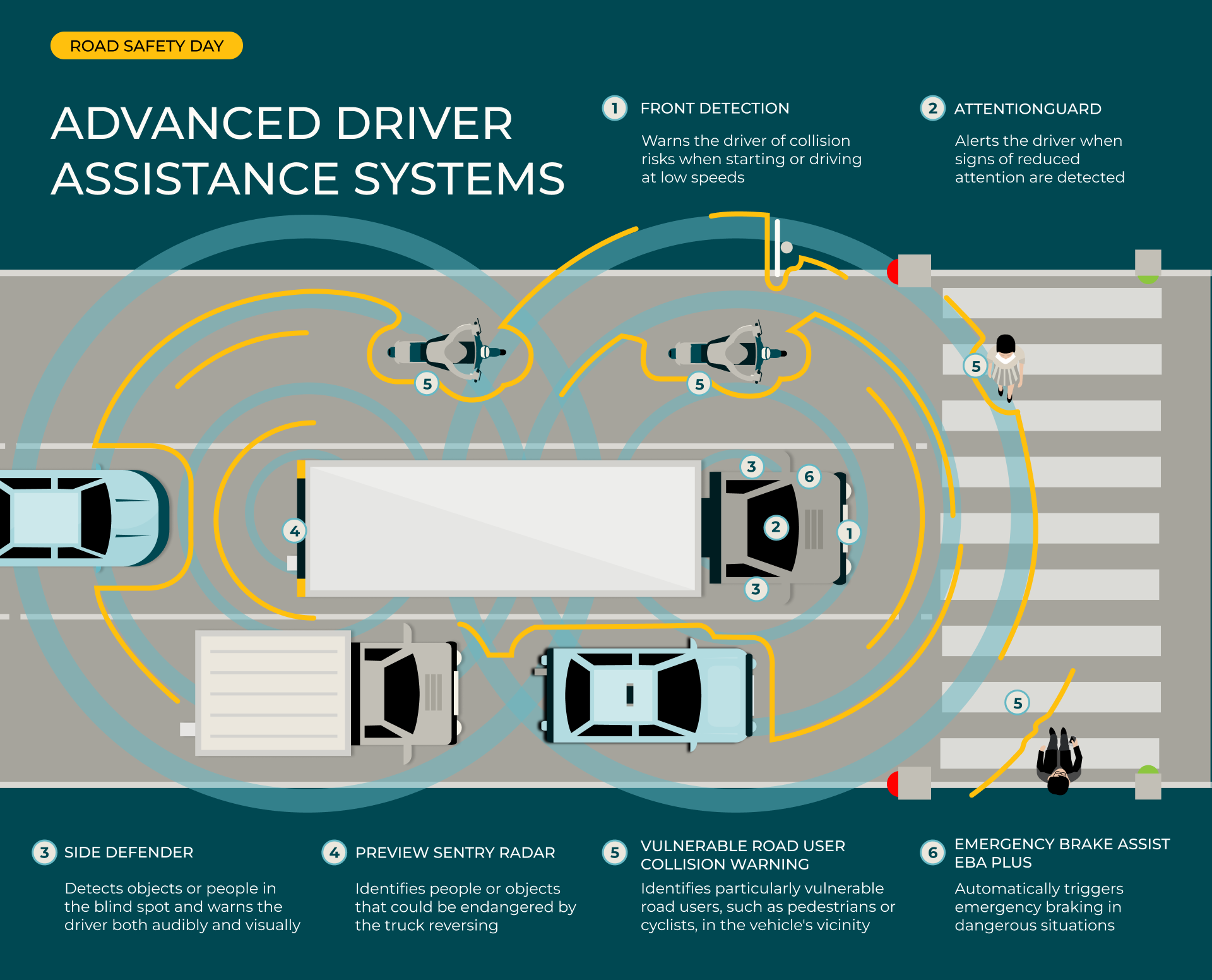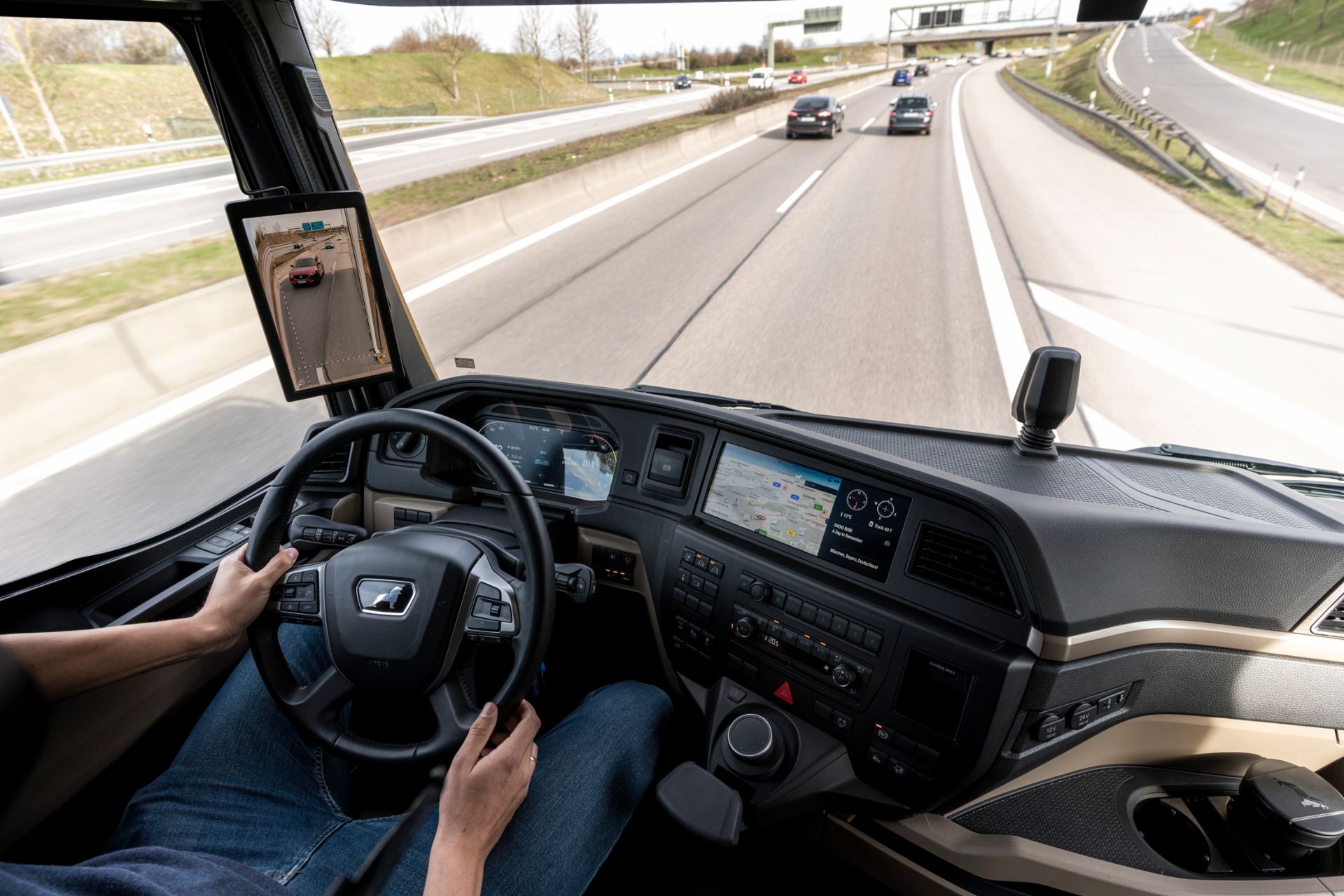Advanced driver assistance systems (ADAS) are crucial for drivers of commercial vehicles, reducing the risk of accidents and helping to protect road users. To mark Road Safety Day, we take a look at some of the innovative solutions developed by TRATON GROUP companies and explore potential future innovations.
How can we make our vehicles even safer? The commercial vehicle manufacturers under the umbrella of the TRATON GROUP are committed to answering this question, with the common goal of making roads safer for everyone. Road Safety Day provides an opportunity for companies in the European market, in particular, to take stock and look ahead, but which technological innovations are currently enhancing safety in TRATON GROUP vehicles, particularly the MAN and Scania brands? How will these technologies evolve?
Road safety is a holistic task for TRATON, involving regular driver training, the use of digital technologies to optimize driving, and the integration of passive protection systems for both occupants and pedestrians. Innovations developed by TRATON brands are implemented throughout the group, and safety engineering technologies are no exception.
In recent years, Advanced Driver Assistance Systems (ADAS) have become a cornerstone of road safety. ADAS comprises a wide range of technologies that enhance driving safety and efficiency. These systems include lane departure warnings, automatic emergency braking, adaptive cruise control, and blind spot detection. With powerful on-board computers like Scania's Next Generation Electrical System or MAN's Central Vehicle Manager, these systems can now detect potentially dangerous situations early and take appropriate action to avoid accidents. This is particularly relevant for commercial vehicles, which pose a higher risk in road traffic due to their size and weight.

New horizons, same commitment to safety and efficiency
ADAS also play a decisive role in increasing the efficiency of the transportation sector. These systems enable smoother driving and greater fuel efficiency, reducing operating costs and protecting the environment.
Significant progress has been made in ADAS development over the past 15 years. One milestone was the introduction of automatic emergency braking systems (AEB) and lane departure warning systems in the early 2010s, which enhance safety by detecting potential collisions and assisting the driver with automatic braking or steering interventions.
The Adaptive Cruise Control (ACC) from Scania, introduced in 2003, exemplifies the impact of such safety systems. At its introduction, it was one of the most significant technical innovations for commercial vehicles. ACC continuously measures the distance and speed of the vehicles ahead and adjusts the truck's speed to maintain a safe distance, accelerating back to the set speed when the road is clear.
Radar and camera technology
The Emergency Brake Assist (EBA) system launched by MAN in 2015 was groundbreaking. This system uses a combination of radar and camera technology to detect potential collisions early and automatically brake if necessary. EBA Plus continuously monitors the traffic ahead, issuing visual and acoustic warnings if an obstacle or slower vehicle is detected. If these warnings are ignored, the system initiates partial braking, and if a collision is imminent, it performs emergency braking to reduce the impact speed or avoid an accident altogether.
MAN's development team further showcased their expertise with SafeStop Assist, a system that intervenes if the driver can no longer steer safely, for instance, in a medical emergency. It triggers a warning and, if there is no response, takes control to bring the vehicle to a safe stop using a combination of driver assistance systems.

Greater protection for other road users
The purpose of ADAS systems extends beyond just protecting individuals within the vehicle, helping to uphold the safety of the other users as well. Scania offers another advanced emergency braking assistance system, AEB VRU, developed to increase the safety of vulnerable road users like pedestrians and cyclists. Using modern sensor and camera technology, it continuously monitors the vehicle's surroundings to detect potential collisions early. If a collision is imminent and the driver does not react, the system triggers emergency braking to avoid or reduce the impact. This function is particularly crucial in urban areas where the risk of accidents involving vulnerable road users is high. MAN offers a similar system, Front Detection, starting from the 2024 model year.

TRATON GROUP brands are continually developing and improving ADAS to ensure maximum safety and efficiency. A notable example is the new MAN TGE Next Level, set to launch in mid-2024, featuring 27 assistance systems, including a cornering assistant, blind spot warning, and collision warning. Highlights include a lane departure warning system that keeps the vehicle in its lane with gentle steering interventions and Crosswind Assist, which stabilizes the vehicle in strong crosswinds. At the time of writing, it is expected that Scania will unveil its new assistance systems later on this year.
EU regulation for greater road safety
With these safety systems, TRATON GROUP vehicles will be well-prepared for the European Union's General Safety Regulation (GSR2), effective for new vehicles from July 2024. The GSR2 aims to enhance vehicle safety within the EU and prevent accidents involving vulnerable road users. It mandates several safety requirements for new vehicle types, including advanced driver assistance systems such as emergency brake assist (AEB), lane departure warning, and intelligent speed assistance systems (ISA).
Additional mandatory technologies include a reversing assistant to minimize accidents while maneuvering.
The regulation lists a total of eight mandatory assistance systems for commercial vehicles:
-
Direction indicators flash during hard braking to signal emergency braking.
-
Monitors tire pressure and warns of under- or over-inflation.
-
Warns the driver of vulnerable road users during turns at low speeds.
-
Uses cameras and/or sensors to indicate obstacles or people behind the vehicle.
-
Warns of potential collisions with unprotected persons in the blind spot.
-
A standardized interface for installing Alcolock devices to prevent driving over the alcohol limit.
-
Monitors driver concentration and warns when a break is needed.
-
Warns of speeding using cameras and GPS-linked traffic sign recognition.
What the future holds
ADAS will become more effective with further AI development, which continuously evaluates sensor and camera data to monitor the vehicle's surroundings and support critical situations. AI analysis of vehicle data also enables preventive maintenance and optimized route planning, reducing operating costs and increasing transportation efficiency.
At MAN, the future of assistance systems is tied to the development of the Central Vehicle Manager (CVM), a central control system in the latest MAN commercial vehicles. The CVM controls and monitors almost all functions centrally, including safety-critical applications like lane departure warning and emergency brake assist, as well as comfort and infotainment systems.
Like MAN, Scania uses AI to improve safety systems and develop autonomous vehicles. In partnership with the Swedish National Center for Applied Artificial Intelligence, it has been testing autonomous trucks for use in restricted areas like mines and container terminals. These vehicles use AI for complex tasks such as navigation and maneuvering without human intervention.
Developments in ADAS at TRATON GROUP demonstrate how technological innovations can enhance road safety. “Through connected systems, advanced driver assistance technologies, artificial intelligence, and continuous sensor technology improvements, the development teams at TRATON GROUP and its brands are constantly setting new standards,” says Johan Berglund, Product Manager, Autonomous & Connectivity at TRATON. Road Safety Day on June 15th highlights the importance of these continuous improvements for the safety of all road users.
